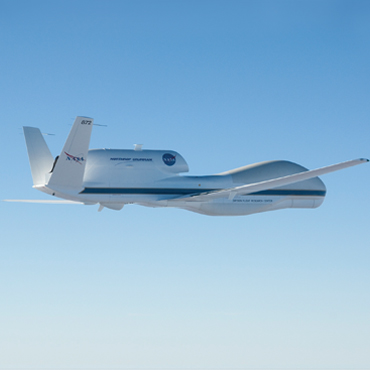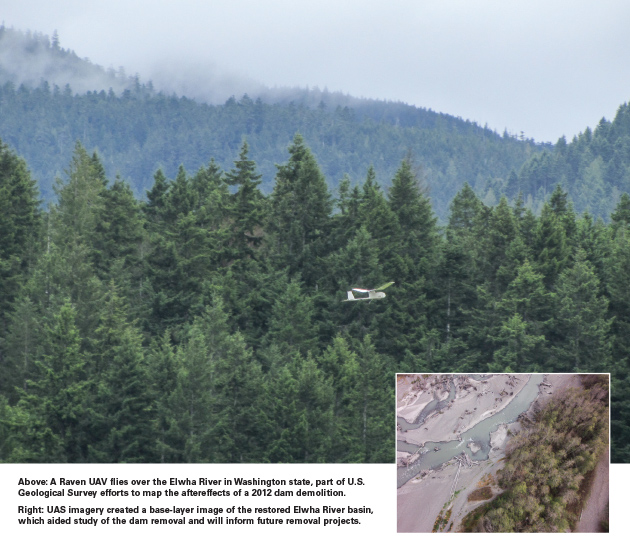Send in the drones

Unmanned aerial systems are steadily spreading from military and intelligence missions to civilian agencies, but it can be a bumpy ride.

NASA's Global Hawk UAVs can stay aloft more than 30 hours at a time and can, over an 11,000-nautical-mile range, track developing hurricanes and study signs of climate change.
Drones, UAVs, UAS -- call them what you will, remotely piloted aircraft are poised to make huge inroads in the national airspace. And although public perception might link unmanned aircraft systems with intelligence agencies and the military, the federal government's UAS user base extends well beyond spies and soldiers.
Agencies as diverse as NASA, Customs and Border Protection, and the Forest Service are all experimenting with UAS and deploying the systems in novel ways.
Drones "can reach hard-to-fly areas and maneuver well at low altitudes," said Jeff Sloan, a UAS operator at the U.S. Geological Survey. "They give us data there's no way you could get with a manned aircraft."
NASA is sending drones through hurricanes and volcanic plumes to collect data, while USGS is using the technology to map changing landscapes. The Border Patrol is scanning for lawbreakers from above, and the Forest Service hopes to better monitor the spread of wildfires. Drones might soon be able to effectively deliver critical supplies in disaster and search-and-rescue situations.
In short, the technology can save money, provide superior data and keep people out of harm's way. Nevertheless, civilian agencies' adoption of UAS is not a straight path forward, and regulatory hurdles and institutional caution are slowing the technology's adoption.
Regulatory restrictions
One major impediment to faster drone adoption is the Federal Aviation Administration. Charged with regulating the nation's airspace, the agency is naturally reticent to open the drone floodgates. And the FAA's reach extends further than many think.
In a recent myth-busting release, the FAA reaffirmed that its jurisdiction starts at ground level, not at 400 feet as commonly stated, and NASA scientists confirmed that FAA rules follow the space agency to parts of the Atlantic Ocean and the Arctic.
In 2012, Congress tasked the FAA with developing a plan for safely integrating UAS into the national airspace by Sept. 30, 2015, and until that plan is completed, civilian agencies must obtain special FAA clearances to use drones. Public operators, including civilian agencies and numerous universities, held 613 active clearances, called certificates of authorization, as of April 8.
Besides the trouble of obtaining authorization from the FAA, agencies must also follow rules that, although well-intentioned, can neutralize the benefits of UAS.
For many smaller drone models, like those deployed by USGS, FAA rules require operators to maintain line-of-sight contact with the vehicles, which Sloan said limits the drones' utility.
The requirement also keeps the Forest Service from sending drones into the smoke of wildfires, thereby undermining one of the biggest potential benefits of UAS: gaining a vantage point unattainable by human pilots.
Plunging in unprepared
The FAA is not the only source of UAS hiccups; other agencies have made some mistakes along the way. In 2007, for example, the Forest Service spent $100,000 on a pair of SkySeer drones that it planned to use to spot illegal marijuana-growing operations on federal land.
Unfortunately, the agency lacked trained operators and FAA approval.
Jeff Ruch, executive director of Public Employees for Environmental Responsibility, said the Forest Service's poorly planned purchase is evidence of a "boys with toys" attitude toward emerging technology.
"There was no planning," said Ruch, whose organization publicized the issue. "They saw the Border Patrol's use of drones and said, 'Oh, that's neat.'"
The Forest Service's drones have now been slated for wildfire tracking, he added, but "it's not clear if that transition will take."
Drones on a budget
Regulatory restrictions have all but forced civilian agencies to be followers in the realm of UAS development, but there's a substantial benefit to letting the military and private industry take the lead: Interested agencies can pick up drones for free.
The Interior Department's USGS owns a fleet, valued at $15 million, of 20 T-Hawks (20-pound drones made by Honeywell) and 15 tiny hand-launched, remote-control Ravens made by AeroVironment.
Although USGS has spent around $1 million on UAS operator training and sensor systems, it paid nothing for the drones themselves.
"Our Ravens are from 2005," said Mike Hutt, UAS project manager at USGS. "The military has moved three generations past those initial Raven models, so they're surplussing the old ones to us."
That military/civilian cooperation has been a boon to USGS. The free Ravens "really helped us cut our teeth on what we can and can't do with drones," he added.
NASA is another agency that is beating swords into plowshares. The agency's Airborne Science Program has been dabbling in UAS since the early 1990s and currently uses such varied drones as the 25,000-pound Global Hawk, the customized-for-science Predator variant Ikhana and the small, maneuverable Dragon Eye.
NASA's fleet of Dragon Eyes was acquired for free from the Marine Corps. "We take whatever we can get," said Bruce Tagg, manager of the Airborne Science Program. "Our scientists are very entrepreneurial; they have their eyes on just about everything."
NASA obtained the Dragon Eyes through the Rube Goldberg process that is interagency procurement: A NASA scientist heard the Marine Corps was getting rid of the drones and asked about having them sent to NASA. The drones went first to the Interior Department, then to the General Services Administration and, finally, as a result of the scientist's persistence, to NASA.
Weighing costs and benefits
Although UAS can bring many benefits, saving money is not always one of them.
"There's a misconception that these UAVs are so much cheaper than manned aircraft," said Matt Fladeland, NASA's UAS manager. "For [small drones such as] Dragon Eyes, that might be true, but for bigger systems like the Global Hawks, there's not much difference [in cost] between running them and running a twin-engine B200."
Between the costs of fuel, trained operators and support systems, flying a large UAS can be just as expensive as a manned flight.
Tagg said the real benefit of large drones is not that they save money but that the unmanned craft can stay aloft for 24 hours in situations where a manned aircraft would last half as long. When monitoring a developing hurricane, for example, the extra airtime can be hugely beneficial, he added.
Small drones bring more direct savings. "In smaller areas -- 10 kilometers by 10 kilometers -- UAS are very good for surveying and bring us a substantial cost savings," said Hutt, who estimated a 10-to-1 savings over traditional manned flights.
Drones also enable agencies to save in other ways. For instance, instead of relying on satellite imagery, USGS can get better photos for less money by strapping a GoPro camera to a low-flying drone. USGS uses data-processing software to make sense of the images collected by drones and gain a sophisticated sense of topography, vegetation cover and more.
"We're finding that $1,000 cameras are giving us data that we used to rely on $400,000 mapping tools to get," Hutt said.
The path forward
The peaceful potential of UAS seems indisputable.
"UAS will assist public safety agencies in responding to natural disasters, locating missing persons or helping to fight wildfires," said Melanie Hinton, senior communications manager at the Association for Unmanned Vehicle Systems International. "In addition, UAS will help farmers care for their crops, [help] to identify diseases, and more precisely and safely spray pesticides."
The organization estimates that the first decade of widespread UAS adoption could produce an $82 billion economic boost in the United States.
The military likes to say drones are used for dull, dangerous and dirty missions, Hutt said, "but we're focused on better Earth science applications, greater safety and savings."
He said he expects FAA regulations, especially the requirement that operators maintain line-of-sight contact with drones, will ease as better radar systems and transponders are developed to keep drones out of the way of other aircraft and one another.
Industry insiders are developing new tools, but they say the existing technology is exciting in its own right.
"Lost-link procedures are pretty standard now, and flight planning is getting better," said Hutt, adding that although they are not fully autonomous, many drones have sophisticated programming to handle emergency landings and extended flights on their own.

Roei Ganzarski, CEO of software developer BoldIQ, is particularly bullish on drones. "The civilian market, once it's opened up, will be a lot bigger than the military market," he said.
Dynamic, real-time optimization of data is BoldIQ's stock-in-trade, and Ganzarski said software can make sense of drone data nearly instantaneously.
Noting that concerns about the prevalence of drones are similar to public fears surrounding the advent of commercial aviation, he added, "There's a view that [drones] will be flying around like mosquitoes, en masse, crashing into each other." But with modern programming, drone fleets can be integrated with one another and the surrounding environment, and dynamic optimization will allow drones to react quickly and competently to changes in the environment, Ganzarski said.
He is convinced that drones are ready for prime time.
"The tech barriers [to UAS integration] don't exist," Ganzarski said. "The barrier is the fear of the unknown."
NEXT STORY: A menagerie of UAVs


